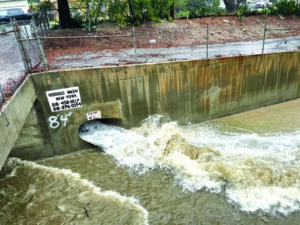
File photo
By Mary O’KEEFE
Recently Governor Gavin Newsom sent out a press release concerning groundwater and the water needs of the State of California.
“California’s water system remains unprepared for the hotter and drier future,” according to a statement from the Governor’s office.
A recent report showed that the state is collecting more groundwater than ever before and is strengthening partnerships with water agencies to ensure that more groundwater is collected, according to the statement.
Crescenta Valley has quite a history with groundwater as levels declined from nearly plentiful to low.
CVW reached out to the Governor’s office and the California Dept. of Water Resources to ask questions about groundwater and what the future may hold for local communities. Below are the questions and answers from the California Dept. of Water.
- 1.How much more groundwater does the state need to serve communities?
Across the state, 85% of Californians depend on groundwater for some portion of their water needs with groundwater also acting as a buffer and supplying up to 60% of the state’s water supply during drought years.
2. Is there anything the public can do to help with data collection?
We encourage the public to engage with their local water management agencies to learn more about the groundwater conditions in their region as well as use tools like CA Groundwater Live (https://sgma.water.ca.gov/CalGWLive/). Residents who rely on wells are strongly encouraged to report when their well goes dry to
https://mydrywell.water.ca.gov/report/ to help inform state and local agencies.
3. Will the Governor be reaching out to the public, including the scientific community like those at JPL, to find new inventive ways to collect groundwater?
California is currently collecting more groundwater data than ever before thanks to new partnerships and technology. We will continue to seek out partnerships and information to support comprehensive data collection.
When asked about groundwater collectionspecifically in Crescenta Valley CVW was referred to the Upper Los Angeles River Area Watermaster, whose office stated it would not be able to answer the question concerning the Crescenta Valley. The question was simple: Will the Governor, or other state offices, be looking at water rights ordinances that tie the hands of many smaller communities?
This question was inspired by the long proposed project by Crescenta Valley Water District concerning the Dunsmore Watershed/Verdugo Wash that runs through Crescenta Valley Park. During rainstorms the wash rushes with water. CVWD had proposed to put a pipe into the wash that would redirect the water to replenish the groundwater in the area. This seemed like a sensible proposal since that water currently runs to the LA River and then out to sea; however, due to LA water rights this water belongs to Los Angeles. There does not appear to be any plans by LA for water reclamation or storage facility for this water’s path.
The City of Los Angeles Dept. of Water and Power (LADWP) is responsible for managing the City’s water rights under the Los Angeles City Charter. Section 673(a) of the City Charter states, “The City shall not sell, lease or otherwise dispose of the City’s rights in the waters of the Los Angeles River, in whole or in part.”
Sections 673(c) and 677(b), however, allow the City “to enter into contracts with any public agency for the exchange of water as long as the water exchanged is replaced in full to the City within a reasonable period set by the board.”
“In other words, LADWP cannot allow Crescenta Valley Water District to use the City’s water rights, but can exchange water with Crescenta Valley,” according to an email response from LADWP in an earlier interview with CVW.
The question still remains and is not complicated: if the state needs to find more ways to collect groundwater will it look at antiquated water rights ordinances as a partial solution?
